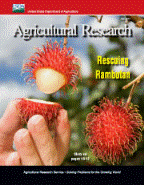United States Department of Agriculture: Agricultural Research Service, Lincoln, Nebraska

Agricultural Research Magazine
Date of this Version
1-2013
Document Type
Article
Citation
Agricultural Research (January 2013).
Abstract
The U.S. Environmental Protection Agency (EPA) estimates that more than 60 percent of dry biosolids—treated wastewater solids that can be recycled or stored—are applied to land, composted, or used to cover landfills. The biosolids have been processed to kill pathogens, and EPA strictly regulates biosolid use to ensure the materials don’t harm the environment, human health, or animal health.
Farmers who follow pre- and post-application management regulations can obtain permits to use biosolids for amending fields where food and feed crops are grown. Now, research by an Agricultural Research Service scientist is helping to clarify the long-term effects that biosolid amendments can have on some soil types—and how the amendments could affect crop production.
“Processed biosolids contain nitrogen and phosphorus that can be used for fertilizer,” says agronomist Eton Codling, who works at the ARS Environmental Management and Byproduct Utilization Laboratory in Beltsville, Maryland. “They also contain copper, manganese, and zinc, which are plant micronutrients. But biosolids also have lead and cadmium, which can contaminate the soil.”
Tracking a Timeline
Codling decided to investigate how long plant-available phosphorus and other minerals remain in soils amended with biosolids and how much phosphorus, copper, cadmium, lead, manganese, and zinc was taken up by wheat grown on those soils. He measured mineral levels in three different soils that had previously received a single amendment of a biosolid processed via one of the following methods: high heat, additions of lime, anaerobic digestion, or air drying.
Included in
Agriculture Commons, Animal Sciences Commons, Food Science Commons, Plant Sciences Commons

